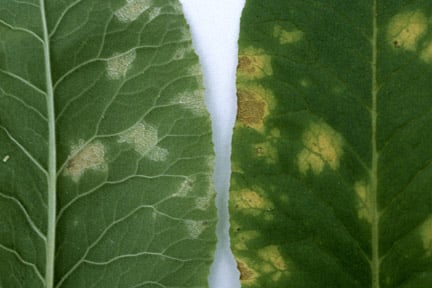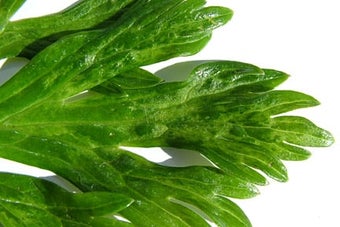
Quick facts
Common name - Primula leaf spots
Scientific name - Various
Plants affected - Primula spp. (primulas)
Main symptoms - Yellow spots, sometimes with mould growth on undersides of leaves
Caused by - Fungi and a bacterium
Timing - From Spring until Winter
What are primula leaf spots?
Leaf spots on primulas are caused by several fungi including Ramularia interstitialis, R. primulae, Phyllosticta primulicola and Puccinia primulae, and appear during wet weather from spring until winter, persisting on leaves all year. The bacterium Pseudomonas syringae can also cause leaf spots.
Leaf spots can occur on primulas, polyanthus and auriculas, although are less common on auriculas.
Symptoms
You may see the following symptoms:
- Yellow spots on the upper surface of the leaves, sometimes with a brown, dead centre. On the corresponding under surface there may be a white fungal growth (Ramularia spp.), minute black fungal structures embedded in the dead tissue (Phyllosticta), or with the rust fungus Puccinia very small orange cup-shaped structures. No growth or structures are visible with the bacterial leaf spot
- Eventually, infected tissues die completely, go brown and may drop out, leaving holes in the leaves

Control
The RHS believes that avoiding pests, diseases and weeds by good practice in cultivation methods, selection, and encouraging or introducing natural enemies, should be the first line of control. If chemical controls are used, they should be used only in a minimal and highly targeted manner.
Non-chemical control
- Remove and destroy infected leaves as soon as infections are seen
Fungicides
The RHS recommends that you don't use fungicides. Fungicides (including organic types) may reduce , impact soil health and have wider adverse environmental effects. If you do intend to use a fungicide, please read the information given in the link and download below to ensure that use, storage and disposal of the product is done in a responsible and legally compliant manner.
The products listed in the ‘Fungicides for gardeners’ document below are legally available for use by home gardeners in the UK. This information is provided to avoid misuse of legal products and the use of unauthorised and untested products, which potentially has more serious consequences for the environment and wildlife than when products are used legally. Homemade products are not recommended as they are unregulated and usually untested.
There is no specific information available on the efficacy of any home garden fungicide against fungal leaf spots of primula. No products with activity against bacterial leaf spot are available to amateur gardeners.
Download
Fungicides for gardeners (Adobe Acrobat pdf document outlining fungicides available to gardeners)
Link
Biology
Species of Ramularia and Phyllosticta cause leaf spots on many plants. Ramularia infections are sometimes called white moulds because of the white fungal outgrowth from infected tissues. Infections caused by rust fungi are not strictly classified as leaf spots, but the symptoms caused by Puccinia primulae on primulas will be seen by gardeners as spots.
Ramularia and Phyllosticta produce spores in the infected tissue and these are spread by water splash to form new infections. They can survive over winter in dead tissues in the form of resting structures. Since most primulas are , there is probably also some survival of the pathogens in lesions on living leaf from one year to the next.
Puccinia primulae spreads by means of airborne spores produced from the small orange structures on the undersides of infected leaves. It also has a type of resting spore which carries the fungus through the winter although it, too, can also survive over winter as infections on the leaves of perennial rosettes. The whole life cycle is completed on primulas, there is no alternate host. Puccinia primulae seems to be confined to Primula vulgaris (primrose) and P. veris (cowslip).
Pseudomonas syringae is also spread by water splash and thus favoured by wet conditions.







